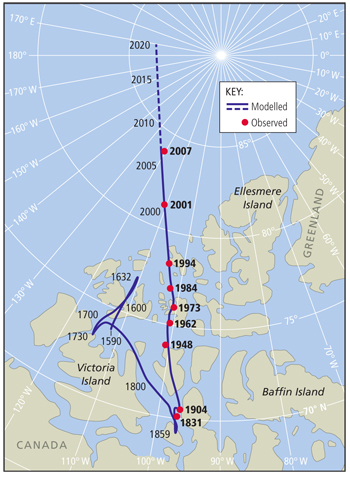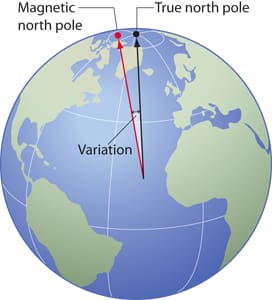The Earth’s Magnetic North Pole, where the lines of magnetic force enter the Earth perpendicular to the globe’s surface, is actually a wandering location. Computer modeling of satellite data has it passing in 2018 closer to the Geographic North Pole than at any other time in its recorded history. What does the movement of this magnetic reference point mean for navigators using magnetic compasses?
English philosopher William Gilbert first calculated the existence of the Magnetic North Pole in 1590 (published in 1600). Since then, through 1831, when British Naval Officer James Clark Ross became the first to reach it physically, and up until 1898, the Magnetic North Pole has meandered aimlessly through the islands and waterways of northern Canada. But since 1898, it has been moving steadily north-northwestward. At the beginning of the 20th century, it advanced about five miles each year. Then in 1970, it began to move faster. Today, the Magnetic North Pole moves about 25 miles each year. Soon, it will be at 86.471° N and 178.755° W, a distance less than 212 nautical miles away from the Geographic North Pole. By 2019, the Magnetic North Pole will have traveled across the International Date Line, into the Eastern Hemisphere, and will be falling away from true north toward Siberia.
The reason we, as mariners and navigators, are interested in this is because of magnetic variation and its effect upon our ship’s compass. Variation, the “V” in the “add East < T | V | M | D | C > add West” formula, is a force outside our boat stemming from our position on the Earth’s surface. It is the angular difference between our geographic and magnetic meridians, expressed in degrees east or west. More simply, it is the difference in degrees between what our compass “feels” as magnetic north versus true north. For sailors on the East Coast of the U.S., the variation in the compass roses on nautical charts is west. On the West Coast, variation is east. For sailors on western Lake Superior and along the Gulf Coast off New Orleans, there is no variation. Boats on these waters are on an agonic line where magnetic north and true north just happen to line up on the same geographic meridian.
There are actually eight north poles. This discussion disregards five of them: the Instantaneous North Pole, the Celestial North Pole, the North Pole of Balance, the North Pole of Inaccessibility and North Pole, Alaska. The last is a suburb of Fairbanks far from the other north poles, but it is the one important to American children at Christmas. We care about these three: the Geographic North Pole, the Magnetic North Pole and the Geomagnetic North Pole.
The Geographic North Pole
This is true north, the northernmost point of the Earth as determined by the northern tip of its imaginary rotational axis. It is a mostly fixed point, subject to only 30 feet of wobble every 433 days. This is the top of the world, 90 degrees north latitude. All the great circle meridian lines of longitude converge here, as do all of the world time zones. Standing (or floating) at this spot, north, east and west no longer exist! The only way that explorers who vanquish these three compass cardinal points can leave the Geographic North Pole is to step south. It does not matter which way to step; in every direction, the only direction is south.
 |
|
Tracking the changing position for the North Magnetic Pole. |
The Magnetic North Pole
The northern end of a magnetized compass needle frequently points here. It is not located at the Geographic North Pole, but it’s close enough to be useful in navigation. The reason it moves about 25 miles each year is due to earthquakes, electrical fluctuations in the Van Allen radiation belts, the ionosphere and the magnetosphere, but it is mostly due to our planet’s internal physical structure. Earth’s magnetic field originates in its core. The inner core is probably solid iron. Surrounding the solid inner core is a molten outer core of liquid metal alloys, mostly iron and nickel, that lies about 1,900 miles beneath our feet. Next out is the mantle that is solid but malleable, and then what we see every day, land and sea, is the crust. As the Earth rotates on its axis, the inner and outer cores rotate too, but each at a different rate, which creates a geodynamo effect. Immense heat from the inner core — hotter than the surface of the sun — caused by radioactive decay and the conversion of potential energy in heavy metals sinking down to the inner core, drives the motion of the liquid metals in the outer core. Convection currents of moving molten metals generate electrical currents that produce the Earth’s magnetic field. And because the source of the Earth’s magnetic field is moving, the Magnetic North and South Poles move as well. If the Earth’s magnetic field were generated by a large, powerful, solid, dipole (two poles) bar magnet within the solid inner core, instead of by moving molten metal alloys in the liquid outer core, the Magnetic North and South Poles would remain mostly static.
Anyway, Earth’s magnetic field emerges from the outer core vertically at the Magnetic South Pole, extends out into space and re-enters perpendicularly at the Magnetic North Pole. A compass needle dips there, trying to point straight down. Accordingly, this pole’s alternate name is the magnetic dip pole, not to be confused with dipole. At the Magnetic South Pole, a compass needle jumps upward. I was there once by boat — the Magnetic South Pole has been off the coast of Antarctica since 1962 — and a compass needle really does try to point skyward!
The Geomagnetic North Pole
The electrical currents created by the convection currents of moving molten metals that generate Earth’s magnetic field are not evenly distributed throughout the liquid outer core. Due to this, the strength of Earth’s magnetic field varies from place to place underground. It is also the reason that the Magnetic North and South Poles are not antipodal, meaning that the imaginary line connecting the two does not pass straight through the center of the Earth. All of these factors combine in such ways that the parts of the Earth’s magnetic field that emerge from the bottom of the world at differing angles with the Earth’s surface (i.e., not perpendicularly) do not also emerge at the Magnetic South Pole as the perpendicular lines of force do. Instead, the location where they do emerge, the Geomagnetic South Pole, and the spot where they re-enter the planet, the Geomagnetic North Pole, are derived mathematically as a best fit for imaginary ends of a solid, dipolar bar magnet that account for the properties of the Earth’s magnetic field, both on the surface and around the planet.
Once up out of the ground and above the Earth, the magnetic lines of force from the Geomagnetic South Pole even out more uniformly. They are not perpendicular, nor even all that vertical. Extending out into space, they curve northward to surround and protect the Earth from the solar wind as the magnetosphere, the northern part of which glows in the solar wind as the Northern Lights of the Aurora Borealis. North of the Arctic Circle, they curve downward once again to re-enter the Earth at the Geomagnetic North Pole, located on Ellesmere Island in Canada, northwest of Greenland, to form closed loops of magnetic force. The Geomagnetic North Pole also moves around from year to year, not as much as the Magnetic North Pole, but for the same reasons.
Although a mathematical derivation, the Geomagnetic North Pole is real enough. Like the Magnetic North Pole, the north end of a compass needle likes to point there, too. Truth be told, most of the time, compass needles actually point to somewhere near the top of the world between the Magnetic and Geomagnetic North Poles. One last point: If the Earth’s magnetic field were generated by a large, imaginary, solid, dipolar bar magnet that passed through the center of the Earth’s solid inner core instead of by electrical currents generated by moving molten metals in the outer core, the Magnetic North Pole and Geomagnetic North Pole would be at the same location. The perpendicular lines of magnetic force would re-enter the Earth at dead center, surrounded by curved ones that re-enter at differing angles.
Most compasses sold are devised to work best in the Northern Hemisphere. A magnetic binnacle compass has a free-spinning compass card that aligns with an agonic line or an isogonic line of the Earth’s magnetic field. Electronic fluxgate compasses measure the relative strength of electromagnetic flux passing through two coils of wire arranged perpendicularly to deduce the direction of the Earth’s magnetic field. The Earth’s magnetic field intensity is between 25,000 and 65,000 nano-teslas. By comparison, a strong refrigerator magnet has an intensity of about 10 million nano-teslas, some 150 to 400 times stronger than the Earth’s magnetic field.
Finally, about the elephant in the room. On that day back in grammar school when we sprinkled iron filings on white paper laid over a dipole magnet, we learned that magnetic lines of force flow from a magnet’s north pole to its south pole. We also learned that opposite poles attract and like poles repel. So, why would the Earth’s magnetic field emanate from its Magnetic South Pole and re-enter the planet at its Magnetic North Pole? And why would the north ends of magnetized needles in compasses all around the Northern Hemisphere want to point North? Well, it does not, and they do not! The Magnetic North Pole of the Earth is really its Magnetic South Pole! Scientists sidestep this fact by referring to the Magnetic North Pole as the “north-seeking” pole, as if to say that the magnetic patterns of force emanating from the Magnetic South Pole (really the Magnetic North Pole) are seeking the pole in the Northern Hemisphere, regardless of its polarity. The same is true of the Geomagnetic North and South Poles as well.
If this is disillusioning, it may be gratifying to learn that some scientists believe the increased rate of movement of the Magnetic North Pole may signal the early stages of a geomagnetic field reversal where the Magnetic North and South Poles would flip and exchange places, perhaps back into their “correct” positions. Rocks have revealed that at least 184 geomagnetic field reversals have occurred over the last 83 million years, roughly between every 100,000 to 1 million years, and that these reversals have usually required between 1,000 and 10,000 years to complete. The last complete and enduring geomagnetic field reversal occurred 786,000 years ago, and it may have occurred within the span of a single human lifetime! A brief, temporary reversal occurred 41,000 years ago during the Ice Age, but it lasted “only” 440 years before reverting. The hypothesized triggers of these recurring geomagnetic field reversals are extra-terrestrial extinction-level impact events, rock slabs the size of a continent sinking into the area between the mantle and the liquid outer core, massive plate tectonic subductions and unknown events that may have caused large-scale disruptions of the molten metal geodynamo running within the liquid outer core, thereby weakening the Earth’s magnetic field, making a rearrangement of the fields more likely, even leading to a geomagnetic field reversal.
Lenox Grasso is an instructor coordinator for the American Sailing Association.

